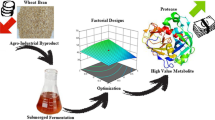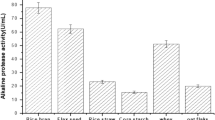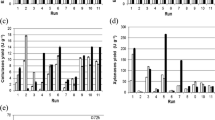Abstract
A newly isolated strain EL31410, producing elastase (E. C3. 4. 4. 7) with high elastolytic activity was identified asBacillus sp. In the medium optimization, it was found that wheat bran and soybean flour hydrosate were the best crude carbon and nitrogen source for enzyme production, respectively. Addition of corn steep flour can affect the bacterium growth and elastase production. A fractional factorial design was applied to study the main factors that affect the enzyme production, and central composite experimental design and response surface methodology were adopted to derive a statistical model for the effect of wheat bran and soybean flour hydrosate on elastase production. The experimental results showed that wheat bran had positive effect but soybean flour hydrosate had negative effect, on enzyme production. An initial concentration of 3.4% (w/v) wheat bran and 9.4% (v/v) soybean flour hydrosate were found to be optimal for enzyme production in batch culture. The time course of elastase production in the optimized medium composition was also described.
Similar content being viewed by others
References
Box, G. E. P. and Wilson, K. B., 1951. On the experimental attainment of optimum conditions.J Roy Stat Soc B,13: 145.
Box, G. E. P. and Hunter, W. G., 1978.In: Statistics for experimenters. John Wiley and Sons, New York.
Chen, Q. H. and He, G. Q., 2002. Optimization of medium composition for the production of elastase byBacillus sp. EL31410 with response surface methodology.Enzyme Microbial Technology,5: 67–72.
Cockshott, A. R. and Sullivan, G. R., 2001. Improving the fermentation medium for Echinocandin B production. Part I: sequential statistical experimental design.Process Biochem,36: 647–660.
Haaland, P. D., 1989. Experimental design in biotechnology. Dekker, New York.
Hwang, S. W., Lee, Y. S. and Yang, K. Y., 2001. Maximization of acetic acid production in partial acidogenesis of swine wastewater.Biotechnology and Bioengineering,75(5): 521–529.
Janda, J. M. and Abbott, L. S., 1999. Identification and Initial Characterization of elastase activity associated withVibrio cholerae.Current Microbiol,39: 73–78.
Kalil, S. J., Maugeri, F. and Rodrigues, M. I., 2000. Response surface analysis and simulation as a tool for bioprocess design and optimization.Process Biochemistry,35: 539–550.
Khuri, A. I. and Cornell, J. A., 1987. Response surface Design and analysis. Dekker, New York.
King, V. A., 1993. Studies on the control of the growth ofSaccharomyces cerevisiae by using response surface methodology to achieve effective preservation at high water activities.Int. J. Food Sci Technol,28: 519–529.
Ma, A. Y. M. and Ooraikul, B., 1986. Optimization of enzymatic hydrolysis of canola meal with response surface methodology.J. Food Proc Preserv,10: 99–113.
Miller, G. L., 1959. Use of dinitrosalicylic acid reagent for determination of reducing sugar.Anal Chem,31: 426–427.
Montgomery, D. C., 1991. Design and analysis of Experiments 3rd Ed. Wiley, New York.
Morihara, K., 1967. Elastolytic properties of various proteases from microbial origin.Arch Biochem Biophys,120: 68–78.
Ozaki, H. and Shiio, I., 1975. Purification and properties of elastolytic enzyme fromFlavobacterium immotum.J Biochem,77: 171–180.
Roseiro, J. C., 1992. Medium development for xanthan production.Process Biochem,27: 167–175.
Rosi, I., Costamagna, L. and Bertuccioli, M., 1987. Wine fermentation by immobilized yeast: an optimization study.In: Flavor Science and Technology, John Wiley and Sons, New York.
Sachar, L. A., 1955. Photometry method for estimation of elastase activity.Proc Soc Expeti Biol Med,90: 323–325.
Saulnier, M. J., Curtil, M. F. and Wallach, M. J., 1989. Elastolytic activity ofPseudomonas aeruginosa elastase.Biochimica. et Biophysca. Acta,995: 285–290.
Shibata, Y., Fujimura, S. and Nakamura, T., 1993. Purification and partial characterization of an elastolytic serine protease ofPrevotella intermedia.Appl Environm Microbial,59(7): 2107–2111.
Shiio, I., Nakamatsu, T. and Ozaki, H., 1974. Microbial production of elastolytic enzymes.Agri Biol Chem,38 (1): 1–7.
Souza, M. C. de O. and Roberto, I. C., 1999. Solid-state fermentation for xylanase production byThermoascus aurantiacus using response surface methodology.Appl Microbial Biotechnol,52: 768–772.
Takagi, H. S., Tsai, Y. C. and Nakamori, S. R., 1995. Improved production and recovery of alkaline elastase from alkalophilicBacillus strain by a change of medium composition.Biosci. Biotech. Biochem,59: 1591–1592.
Thayer, 1991. Three-dimensional structure of the elastase ofPseudomonas aeruginosa at 1.5Å resolution.J Biol Chem,286: 286–2871.
Tsai, Y. C. H., Jung, R. Y. and Lin, S. F., 1988. Production and further characterization of an alkaline elastase production by alkalophilicBacillus strain YaB.Appl Environm Microbial,54 (1): 3156–3161.
Tsuzuki, H. and Oka, T., 1965.Pseudomonas aeruginosa elastase: isolation, crystallization and preliminary characterization.J Biol Chem.,240 (8): 3295–3303.
Zins, M. M., Zimprich, A. C., Petermann, R. S. and Rust, L., 2001. Expression and partial characterization of an elastase fromChromobacterium violaceum.Veterinary Microbiology,80: 63–74.
Author information
Authors and Affiliations
Corresponding author
Additional information
Project (No. 300024) supported by the Zhejiang Provincial Natural Science Foundation of China
Rights and permissions
About this article
Cite this article
He, Gq., Chen, Qh., Zhang, L. et al. Influence of medium components on elastase production using crude sources byBacillus sp. EL31410. J. Zhejiang Univ. Sci. A 4, 142–151 (2003). https://doi.org/10.1631/jzus.2003.0142
Received:
Accepted:
Published:
Issue Date:
DOI: https://doi.org/10.1631/jzus.2003.0142
Key words
- Elastase
- Bacillus sp. EL31410
- Crude sources
- Medium optimization
- Fractional factorial design (FFD)
- Central composite design (CCD)
- Response surface methodology (RSM)
- Batch cultivation




